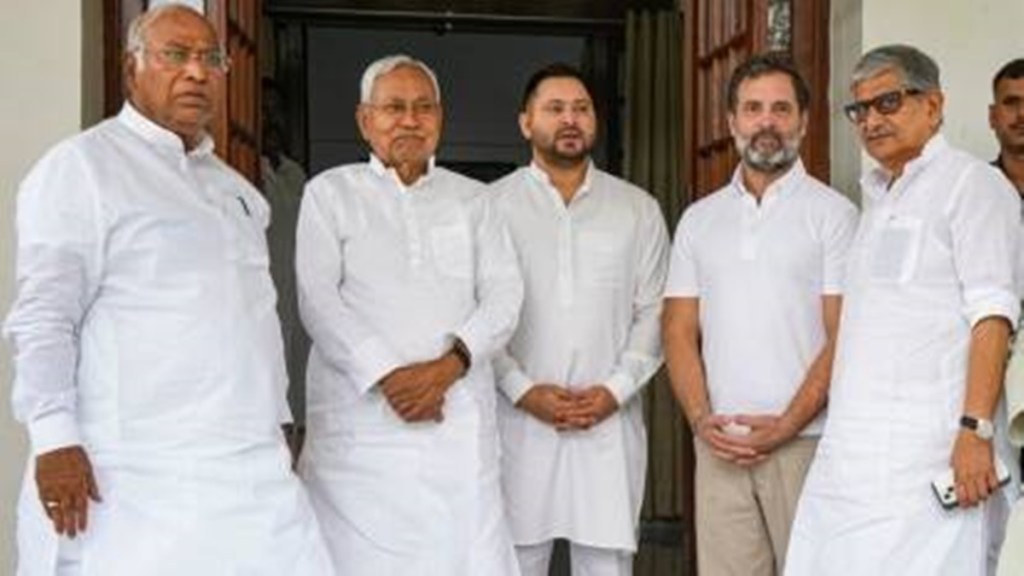Key opposition leaders arrived in Bihar’s capital Patna on Friday for the first significant meeting of the Opposition parties aimed at forging unity for the 2024 Lok Sabha polls.
The meeting is an important milestone in India’s recent political history, given its scale, composition, ambition and aspirations.
Not since the late 1980s have so many disparate regional parties joined hands at the national level. The Bharatiya Janata Party (BJP), though in denial, could be in trouble if it comes up against a united opposition.
And this time, the presence of the Congress, which has been one of the main pillars of Indian politics, makes a huge difference, apart from the sheer participation of so many regional parties with significant political and electoral heft in the states.
After all, it was anti-Congressism which had united the socialists, breakaway Congress satraps, Jan Sangh leaders, and the Communists in the 1970s.
Such allainces took shape mostly post elections for formation of government, while those formed pre-elections were short-lived.
The solitary success for a united opposition was in the 1977 general election, when the then ruling Congress was thrown out of power by a coalition of parties across the political spectrum.
The National Front, a coalition of rebel Congress leader V P Singh-led Jan Morcha, Janata Party, TDP, Lok Dal, DMK, Congress (S) and the AGP, was formed to keep the Congress out of power. VP Singh’s government collapsed in less than a year as the BJP withdrew support and Chandrasekhar walked out of the Janata Dal with 64 MPs and floated the Samajwadi Janata Party.
Rajiv Gandhi propped Chandrasekhar as Prime Minister, supporting him from outside. Four months later, Chandrasekhar’s minority regime too collapsed after the Congress pulled the plug on it.
The major alliances including the United Front in 1996, the BJP-led NDA from 1998 to 2004 and the Congress-led UPA from 2004 to 2014 were all post-poll alliances with parties regularly walking in and walking out.
After the 1996 elections, which returned a fractured verdict, Janata Dal, Samajwadi Party, Dravida Munnetra Kazhagam, Telugu Desam Party, Asom Gana Parishad, All India Indira Congress (Tiwari), Left Front (4 parties), Tamil Maanila Congress, National Conference, and Maharashtrawadi Gomantak Party formed a 13-party United Front (UF) to keep the BJP out of power.
The Congress and the Left supported the Front from outside. But the experiment was short-lived once again.
HD Deve Gowda’s term ran from June 1, 1996 to April 21, 1997. The Congress withdrew its support for Gowda due to disagreements between the alliance and the Congress. Nonetheless, the party agreed to support a new government led by IK Gujral.
He served as prime minister from April 21, 1997 to March 19, 1998. But due to internal squabbling and differences with the Congress, his government fell apart and the United Front lost power.
The Congress insisted on the DMK’s removal from the coalition as the Jain Commission Report on Rajiv Gandhi’s assassination suggested that the DMK, a UF component, had a role to play in it. But Gujral was admant on having the party in the coalition.
India went to the polls once again in 1998, and the fragile nature of the Third Front became a powerful campaign tool for the BJP, and it won the elections.
But 13 months later in April 1999, Prime Minister Atal Bihari Vajpayee had to face no-trust motion, which he lost by a single vote after the BJP’s coalition partner – the AIADMK — withdrew support. While the BJP-led National Democratic Alliance (NDA) coalition secured 269 votes, the opposition got 270.
As the opposition under the leadership of Congress’ Sonia Gandhi was unable to come up with the numbers to form government, the Lok Sabha was again dissolved and fresh elections were held. Vajpayee remained the “caretaker” Prime Minister until the polls were held.
In the 1999 Lok Sabha elections, the BJP-led NDA secured a comfortable and stable majority. After winning 303 seats out of the 543 seats, the first, stable NDA government was formed that ran for a full term.
Most of the regional parties — except for the SP, BSP, RJD, and the Left — were part of the NDA at one point of time or other from 1998 to 2004.
The UPA too was a post-election alliance formed in 2004 to throw out the BJP from power.
Ahead of the 2014 Lok Sabha polls, another effort was made to form a Third Front with as many as 11 parties — seven regional parties and four from the Left bloc. The regional parties were the SP, JD(S), AIADMK, JD(U), Jharkhand Vikas Morcha, BJD and the AGP.
“It is time for a change and to throw out the Congress from power… The BJP and the communal forces must be defeated and prevented from coming to power,” a joint statement issued by these parties then declared.
Since 2014, not many attempts have been made to forge national coalitions or fronts. In 2018, BRS chief K Chandrasekhar Rao attempted to form a Third Front and held meetings with BJD president Naveen Patnaik and Trinamool Congress chief Mamata Banerjee, but a front could not come into existence.
In this context, Friday’s Patna meeting assumes significance as it is the first time that the Congress is supporting the formation of a pre-poll front. Also, the regional parties which are participating in the conclave are dominant or influential forces in their respective states.
Bihar Chief Minister Nitish Kumar is playing host to the opposition meeting. Congress, TMC, AAP, NCP, Shiv Sena (UBT), Dravida Munnetra Kazhagam (DMK), Jharkhand Mukti Morcha (JMM), Samajwadi Party (SP), National Conference (NC), Peoples Democratic Party (PDP), CPI, CPM, CPI ML, JDU, Rashtraiya Janata Dal (RJD) are participating in the meeting.

